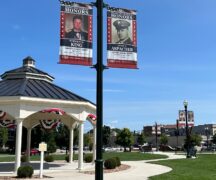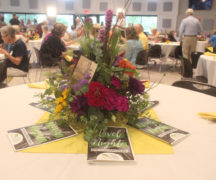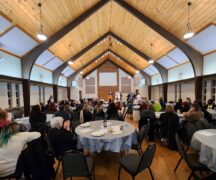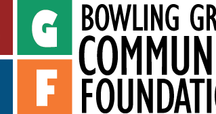By JAN McLAUGHLIN
BG Independent News
Just in time for Memorial Day, 164 veterans banners are being posted on light poles around the city of Bowling Green.
The banners honor those who served in the military from Bowling Green, and a link on the city’s website tells of their lives, and in some cases, their deaths.
The Hometown Heroes Banner Program is the product of teamwork between the city and the Bowling Green Community Foundation. The 30-by-60-inch banners are being placed on light poles throughout the downtown on North and South Main streets, East and West Wooster streets, around Wooster Green, and City Park.
The veterans banner project began as an idea by Bowling Green Community Foundation President Marcia Latta to celebrate the 30th anniversary of the foundation. As the banners have been installed, Latta has driven through the downtown and walked in the park to view the progress.
“I’ve been like a mother hen,” she said. “Every few hours I look to see the progress.”
During one of her rounds, she came upon a family taking photos of one of the banners. “They were getting photos to send to other relatives who live out of state,” Latta said. “This gives something tangible that their loved ones can share with their stories.”
Families of each veteran were given smaller versions of the banners to place at their homes.
“It’s been very touching, very humbling as family members have come to pick up the mini-banners,” Latta said. “It’s been a very moving experience, a wonderful addition to the community.”
The Bowling Green Community Foundation, aided by a donation from the Al and Mary Green Family Fund, collected information about Bowling Green area veterans from their families and had the banners created.
The foundation was helped with the project by Bowling Green Mayor Mike Aspacher and his staff, Wood County Veteran Services, various veterans groups in Bowling Green, and community donors.
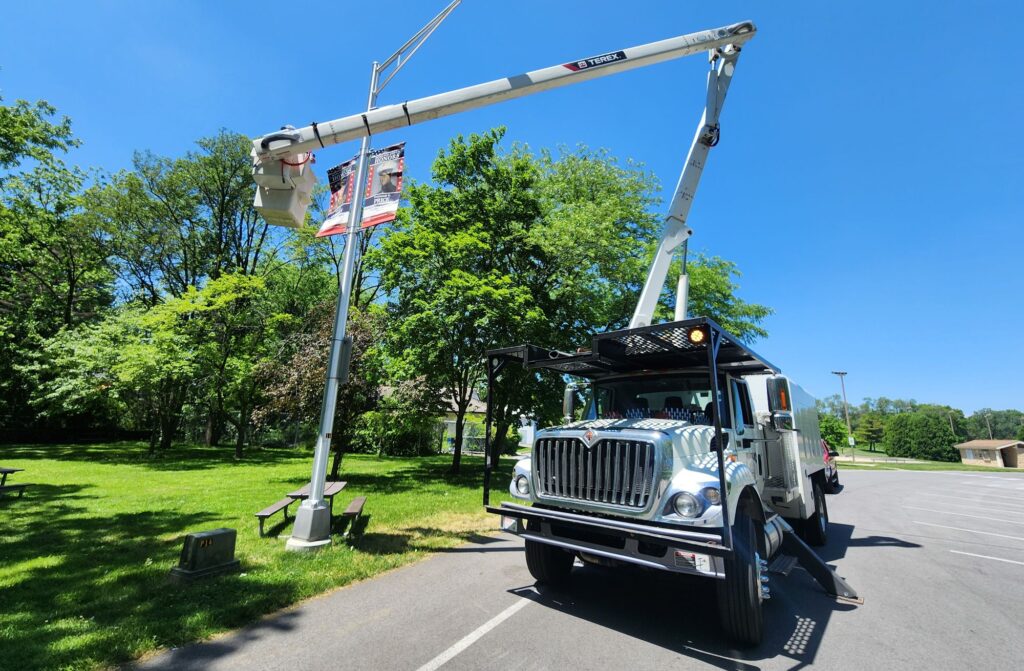
City employees installed brackets on light poles, and are now adding the banners. Jason Heyman, a city employee, created a GIS program for the Hometown Heroes Banner Project.
Hometown Heroes GIS Program — Bowling Green Community Foundation (bgohcf.org)
The interactive map allows people to find certain veterans by typing in their names, and to read details submitted by their families. By clicking on a banner’s location, viewers can learn more about the individual’s service history and contributions.
How to use the map:
- Zoom In/Out: Get a closer look or view the entire city.
- Banner Icons: Each green dot icon represents a veteran’s banner.
- Information Pop-Ups: Click on an icon to see details about the veteran.
A gallery of photos is also available that shows all the veterans honored on the banners. https://www.bgohcf.org/hometownheroesgallery
Some of stories shared about local veterans include:
Larry Sattler was drafted into the U.S. Army in 1959 and after basic training was assigned to the Honor Guard in Washington, D.C. He participated in burial details and presidential functions for both Eisenhower and Kennedy. His enlistment was extended due to the Cuban Missile Crisis. After his service he returned to Bowling Green to continue his occupation as a sign painter, and founded Century Signs in 1957.
Charles Smith started working in his parents’ welding shop on Napoleon Road at age 8. He worked as a welder until he was drafted into the Navy for World War II. He entered having a preferred assignment of being a carpenter because he was tired of welding. Initially, he did not wish to be recognized as a highly skilled welder. However, Smith later received recognition for his outstanding service in repairing a ship that sustained a major break at sea. The assigned sailor welders onboard the ship were unable to repair the ship. So Smith welded the metal breakage on the ship that was in need of dire and immediate repair. His ship experiences included seeing the raising of the U.S. flag on Mount Suribachi during the Battle of Iwo Jima. Smith earned the American Area Ribbon, Asiatic Pacific Area Ribbon with One Bronze Stars, Philippine Liberation Ribbon, and the World War II Victory Ribbon. On his uniform the actual extended ribbon has two bronze stars. When he returned to Bowling Green he became known as an expert welder.
Stanley Layne Fisher, who served in the U.S. Navy, was serving on a ship that was sunk by a kamikaze attack during the Okinawa Island battle. Fisher and 49 other shipmates were killed and went down with the USS Emmons. The ship is now a naval shrine. Fisher was a 1936 graduate of BGSU and the archery champion of the New York World’s Fair in 1940.
Richard Wenig was serving in the 407th Infantry when he participated in the crossing of the Roer River, Germany, on Feb. 23, 1945. Wenig “courageously risked his life in heavy enemy fire to bring ammunition to his heavy weapons company. He was pinned down for 10 minutes by intense enemy artillery and mortar. He accomplished his mission and forced 15 soldiers to surrender.”
Terry Titus, who served with the U.S. Air Force, was the first Wood County citizen who died in Vietnam in 1965.
Lyle Bordeaux was shot down multiple times while serving in the Air Force, flying the plane until his troops were off. He was captured and survived and went on to train pilots. He retired from combat crew duty in the Air Force and the Strategic Air Command in 1966, where he flew many types of aircraft including the B-17, Flying Fortress, B-36 Peacemaker and B-52 StratoFortress.
Robert Pultz was drafted into the Army at the age of 18 and deployed to Vietnam in 1966. Robert served as a medic until he was killed in action on Dec. 6, 1967. While in the service, he was awarded five medals.
Donald Spencer was serving in the Army in Sadr City, Iraq, when he was killed in action by a bullet shot into his neck while on patrol in 2014, during the Global War on Terror.
Ned E. Baker served in the Military Police with the Army in WWll. He was stationed in Munich, Germany, where he worked securing prisons that held war criminals.
Norm Garner was the flight engineer on a B-24 with the 15th Air Force stationed in Italy with the 485th Bomb Group, 830th Squadron. Once the crew flew 50 bombing missions, they were released to go stateside. All the crew members flew their 50 missions together with the exception of their pilot who had missed one mission due to illness. The crew bravely decided they needed to fly one more mission with him piloting so they could all go home together. Sadly, the next crew assigned to their plane, named “Fifty Missions from Broadway,” never made it back to base on their first assignment.
Robert Oberhouse served in the Army during WWII. On Dec. 23, 1943, 33 soldiers in the 37th division walked into the jungle on the Island of Bougainville when the Japanese attacked. Only three of the soldiers survived. Oberhouse was wounded by Japanese Knee Mortar. Shrapnel blew out his right eye, passed through the bridge of his nose and cut the optic nerve in his left eye. He was severely wounded in his right bicep, leaving a scar nearly 10 inches long. He said he remembered lying there, wounded and unable to move, while the bombs were exploding around him. Under the cover of darkness, his comrades grabbed him and shoved a braided belt in his mouth. As they dragged him to safety, he was in so much pain that he bit the belt in half. While he was not Catholic, a priest who worked with the soldiers, saw Oberhouse’s wounds and was so concerned, he performed last rites. Before being placed under anesthesia, Bob heard the surgeon say, “Those eyes look really bad and that right arm will have to come off.” When he woke up, he still had his arm. For his service, Oberhouse received a purple heart, an Asiatic-Pacific Ribbon with one Bronze Star, and a Good Conduct medal. He was the first blind man to attend and graduate from Bowling Green State University, going on to work as a rehabilitation counselor for the Ohio Bureau of Services for the Blind.
James Oberhouse, older brother of Bob Oberhouse, worked for the Civilian Conservation Corps until he enlisted in the Marine Corps, in September of 1940. He served on the gun crew of the U.S.S. Erie off the coast of Panama. His crew shot down three Japanese reconnaissance airplanes before the attack on Pearl Harbor. Because of his amazing shooting abilities, he was transferred to Marine Corps Boot Camp as a rifle instructor. As the war progressed, he was shipped to the South Pacific. While fighting with the 6th Marine Division on the Island of Okinawa, James was killed on May 30, 1945.
There will be a dedication ceremony for the Hometown Heroes banners on June 9, coinciding with a Community Band Concert at City Park, starting at 7 p.m. At the conclusion of the concert, the names will be read aloud of all the veterans honored on the banners. People are asked to bring lawn chairs.
“We invite the community to join us in honoring our Hometown Heroes and expressing our gratitude for their service,” Latta said.


